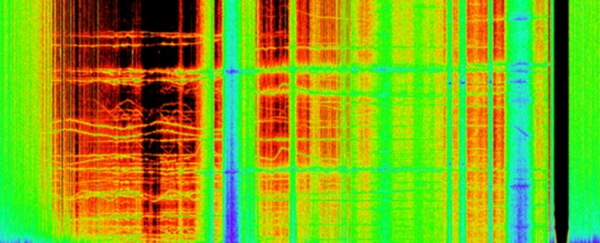A NASA high-altitude balloon experiment run by graduate students in the US has captured some unexplained and strangely complex sounds at 36 km (22 miles) above the surface of Earth. Known as atmospheric infrasound, these sound waves dip below frequencies of 20 hertz, which is beyond the range of human hearing.
Sped up in the recording above so we can actually hear them, the noises are an eerie jumble of what sounds like paper rustling, a robot screaming, some crackles, static, and a whole lot more screaming. "It sounds kind of like The X-Files," Daniel Bowman, a doctoral candidate in geophysics at the University of North Carolina who, designed and built the equipment that recorded the sounds, told Becky Oskin at LiveScience.
Bowman built microphones capable of recording infrasound waves, and attached them to NASA's High Altitude Student Platform (HASP) - an enormous helium balloon that carries 12 student payloads 37 km above Earth's surface every year as part of an initiative to get them interested in an aerospace career path.
After the nine-hour flight, Bowan and his peers' projects entered an atmospheric region known as 'near space' - putting it high enough to be in the zone of aeroplanes, but too low to have hit the stratosphere at 100 km (62 miles) up.
These were the first sounds record in near space aboard a NASA student balloon experiment in over half a century, any while infrasounds are known to be made from many types of natural phenomena, such as earthquakes and storms, the source of some of the crackles and shrieks in this recording remain a mystery.
Becky Oskin explains at Livescience:
"Here are some of their guesses so far: There were signals from a wind farm under the balloon's flight path, crashing ocean waves, wind turbulence, gravity waves, clear air turbulence, and vibrations caused by the balloon cable. The scientists have another payload planned for the 2015 HASP balloon launch, which could help reveal more about strange infrasound sources."
"I was surprised by the sheer complexity of the signal. I expected to see a few little stripes," Bowan told her. "There haven't been acoustic recordings in the stratosphere for 50 years. Surely, if we place instruments up there, we will find things we haven't seen before."
NASA plans to send more recording devices up there this year aboard their HASP vehicle to hear more of these peculiar sounds. In the meantime, head to the European Space Agency's (ESA) Soundcloud account to listen to a collection of 'space sounds' they've been gathering. If the truth is out there, I bet our grad students can find it.
Source: Livescience
